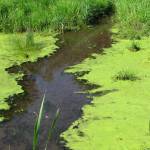Pythiosis a Risk for Horses in Wet Pastures

Not every horse that walks in muddy pond or streambank areas will develop pythiosis, a skin disease characterized by firm, lumpy nodules that drain bloody serum. However, Pythium insidiosum is found worldwide in warm regions with vegetated wetlands and is responsible for various illnesses that affect humans, other animals, and plants. Known as swamp cancer in Australia and the U.S., pythiosis most commonly affects horses that are in contact with water or flooded soil containing the infective-stage zoospores of P. insidiosum.
Though the microbes are not thought to be capable of penetrating an animal’s skin, they may enter through small injuries such as insect bites. Within two to three weeks after exposure, affected horses begin to develop granulomatous skin lesions, which contain lumps of dead tissue helpful in differentiating pythiosis from proud flesh, sarcoids, and other growths.
Treatment is most effective if it is begun early in the course of the disease. Surgery to remove affected tissue may be followed by treatment with antifungals and other drugs. Horses don’t develop antibodies to the microbes and can be reinfected if they are exposed again. Avoiding pythiosis involves management to keep horses away from wetlands during warm weather, especially in areas where pythiosis outbreaks have been reported.
Healthy skin for horses begins with excellent overall nutrition. Horse owners should start by providing a diet of high-quality forage, often paired with grain as needed to supply extra energy for growth or performance. To support skin condition, owners can use a nutritional supplement like Bio-Bloom PS (Bio-Bloom HF in Australia). This dual-action supplement was designed by Kentucky Equine Research to promote and maintain healthy skin and hooves from the inside out.








